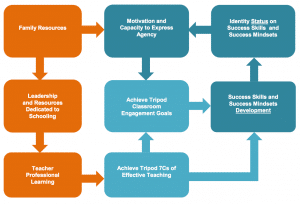10 Tips for Developing Student Agency
CompetencyWorks Blog

This post originally appeared at Getting Smart on December 22, 2015.
Agency is the capacity and propensity to take purposeful initiative—the opposite of helplessness. Young people with high levels of agency do not respond passively to their circumstances; they tend to seek meaning and act with purpose to achieve the conditions they desire in their own and others’ lives.
A new Harvard study, sponsored by the Raikes Foundation, suggests that student agency may be as important an outcome of schooling as basic skills.
The report, The Influence of Teaching Beyond Standardized Test Scores: Engagement, Mindsets, and Agency, relies on the Tripod survey of teaching. Over 300,000 students in grades six to nine in 14 states were surveyed during the 2013-14 school year.
Developed by Ron Ferguson 15 years ago, the Tripod construction appears more relevant to traditional teacher-centered classrooms than student-centered approaches. As a result, there are some limitations of an instrument designed for measuring agency in low agency environments. However, next generation Bay Area models including Summit Public Schools and Education for Change (EFC) find the survey useful.
“Where this report is effective is in pushing us to think about agency in the context of what grown-ups have to do to facilitate it,” said Hae-Sin Thomas, CEO of EFC. “Tripod unfortunately is not a tool designed specifically to evaluate teacher practice specific to agency, but it’s as good as it gets with respect to student surveys and student-centered teacher practice.”
Why agency?
An important subset of Habits of Success (discussed last week), agency, the capacity and propensity to take purposeful action, is key to success in life.
Albert Bandura said:
Through agentic action, people devise ways of adapting flexibly to remarkably diverse geographic, climatic and social environments; they figure out ways to circumvent physical and environmental constraints, redesign and construct environments to their liking… By these inventive means, people improve their odds in the fitness survival game.
Hitlin and Elder suggest four overlapping conceptions of agency:
- Existential agency: The capacity, or free will, for exerting influence on our environments.
- Programmatic agency: Following rules and routines.
- Identify agency: What we believe about ourselves and the ways that we wish to be perceived by others.
- Life-course agency: Actions that we take to affect future outcomes.
10 Guidelines for Teaching
The Influence of Teaching report makes 10 suggestions for teaching.
| Factor | Description | Guidelines for Teaching |
| Care | Emotional sensitivity and responsiveness | Be attentive and sensitive, but avoid a tendency among sensitive teachers to coddle students in ways that may lower standards and undermine agency. |
| Confer | How welcoming the teacher is to student perspectives | Encourage and respect students’ perspectives and honor student voice but do so while remaining focused on instructional goals; avoid extended discussions that have no apparent purpose and thereby fail to model self-discipline and cultivate agency. |
| Captivate | How captivating classes are | Strive to make lessons stimulating and relevant to the development of agency. If some students seem unresponsive, do not assume too quickly that they are disinterested or disengaged. Some students—and especially those who struggle—purposefully hide their interest and their effort. |
| Consolidate | Making learning coherent | Regularly summarize lessons to remind students what they have learned and help them encode understanding in memory, even when they seem reticent or disinterested. Consolidation helps to solidify student learning. |
| Clarity | Clear up confusion | Take regular steps to detect and respond to confusion in class, but in ways that share responsibility (and agency) with students for doing the thinking. Strike a balance between keeping hope alive for struggling students, on the one hand, versus pressing them to take responsibility for their own learning, on the other hand. |
| Clarify | Lucid explanations | Strive to develop clearer explanations— especially for the material that students find most difficult. Also, related to both clarify and captivate, and consistent with the themes in this report, develop lucid explanations of how the skills and knowledge you teach are useful in the exercise of effective agency in real life. |
| Clarify | Instructive feedback | Give instructive feedback in ways that provide scaffolding for students to solve their own problems; through instructive feedback, you provide the type of support that enables students to develop and express agency by correcting their own work, solving their own problems, and building their own understandings. |
| Challenge | Require rigor | Press students to think deeply instead of superficially about their lessons; set and enforce learning goals that require students to use reasoning and exercise agency in solving problems. Expect some pushback from students who might prefer a less stressful approach. Try increasing captivation and care in combination with rigor in order to help mitigate the tension and make the experience more enjoyable. |
| Challenge | Require persistence | Consistently require students to keep trying and searching for ways to succeed even when work is difficult. Emphasize the importance of giving their best efforts to produce their best work as a matter of routine. Be confident that few things could be more important for helping your students to develop agency. |
| Classroom management | Orderly, respectful, and generally on-task. | Strive to achieve respectful, orderly, on-task student behavior in your class by teaching in ways that clarify, captivate, and challenge—in support of agency—instead of merely controlling students through intimidation or coercion. |
More Than Teaching
The report logic map is shown below. It suggests that teachers and family assets play a major role in support agency development.

The central question explored by this report is, “How do distinct components of teaching influence the development and expression of agency-related factors in sixth to ninth grade classrooms?”
A more useful question, given advances in tools and schools in the last 15 years, would be, “How do distinct components of learner experience influence the development and expression of agency, factors related to learning models, progressions, and environments?”
A useful complement to this report is exploring how new models, like NGLC grantees, promote agency through:
- Blended learning environments where students have some ability to co-create path, pace, and place;
- Competency-based learning environments where students show what they know and progress based on demonstrated mastery;
- Project-based and interest-based learning where students have some ability to shape the driving question, the process, and the work product; and
- Work and service learning experience that students select or create.
The report completely misses model-based factors which are becoming at least as important as teacher factors. The difference between a Summit or EFC secondary school and a big bad high school is everything. There are certainly differences in teacher quality, but it’s one of a dozen model factors (e.g., mission, schedule, structure, advisory, technology blend, learning trajectories, and real world connections).
The report dumps a lot in teacher’s laps but most of them are stuck in an obsolete low agency model that infantilizes teenagers rather than empowering them to own their learning.
Every high agency secondary school I have visited has had some kind of an advisory structure. The sustained relationship with a caring adult that sets the cultural tone, is part of a distributed guidance system, and provides continuous feedback on success habits is every bit as important as classroom instruction in developing student agency.
Agency development isn’t just a product of quality teaching, it’s the product of a quality system–one designed as a high agency environment.
Hae-Sin Thomas said, “It’s definitely time to take this conversation around agency to a deeper level– what are the components of agency, how do we measure those components, how do we map those components to specific practices, conditions or attitudes and then how do we measure those specific to building agency.”
See also:
- Student Agency is What Counts
- ‘Student Agency’ Is Not Something You Give or Take
- Learner Agency: The Missing Link
Sydney Schaef, M.BA., M.Ed., is an educator, entrepreneur, and school design consultant. She currently works as a Mastery Learning Designer at reDesign and a design consultant for Building 21. She served at the School District of Philadelphia from 2013-2015 in the Office of New School Models, and prior to that, served as Founder and Executive Director of a 501c3 nonprofit organization that led innovative education and youth development programs in East Africa. Follow Sydney on Twitter at @sydneyschaef.